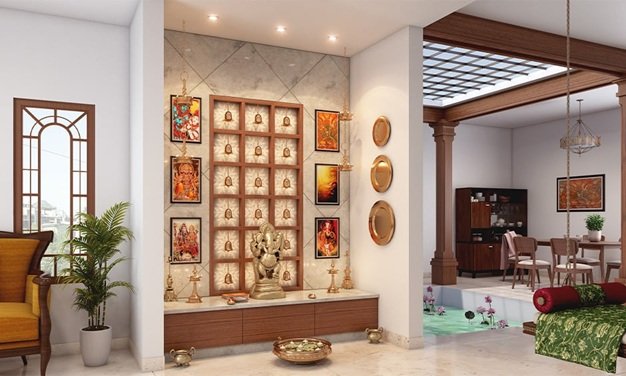The pooja room, or prayer room, is a sacred space in Indian households where individuals connect with their spirituality and perform rituals. It is not only a place for worship but also a reflection of cultural heritage and personal beliefs. Incorporating Indian home decor into your pooja room can enhance its sanctity and create a serene environment for prayer and meditation. This article will explore various elements of Indian decor that can elevate your pooja room, from traditional furnishings to artistic representations of deities, along with tips on color schemes, textiles, and overall ambiance.
Understanding the Significance of the Pooja Room
The pooja room holds a significant place in Indian homes, representing a physical and spiritual connection to the divine. It is a space where family members gather to perform rituals, celebrate festivals, and offer prayers. According to Vastu Shastra, an ancient Indian architectural science, the placement and design of the pooja room play a crucial role in promoting positive energy and harmony within the home. Therefore, incorporating Indian home decor into this space not only enhances its aesthetic appeal but also aligns it with spiritual principles. The decor can range from traditional wooden furniture to intricate artwork that embodies the essence of Indian culture.
Choosing the Right Color Palette
The color palette of your pooja room is vital in creating a calming and inviting atmosphere. Traditionally, Indian homes utilize warm colors such as saffron, deep reds, and gold, which symbolize auspiciousness and positivity. These hues can be used on walls, decorative items, or textiles. Soft pastels and earthy tones can also be incorporated to create a serene ambiance, especially if your pooja room is a smaller space. It’s essential to strike a balance between vibrant colors and softer shades to ensure the room feels welcoming and peaceful. Additionally, using natural materials, such as clay or wood with natural finishes, can enhance the earthy feel of the space.
Incorporating Traditional Indian Furniture
Furniture plays a crucial role in defining the pooja room’s character. Traditional Indian furniture, such as a wooden altar or a pooja mandap, can serve as a focal point for your worship space. Altar designs often feature intricate carvings and motifs that depict various deities, adding an artistic touch to the decor. Consider using a low wooden platform, known as a ‘chowki’, for placing deities, candles, and offerings. You can also opt for decorative stools or benches made from teak or rosewood, which not only provide seating but also add elegance to the room. These pieces of furniture can be adorned with brass or copper accents, further enhancing the traditional look.
Artistic Representations of Deities
Artwork plays a significant role in Indian home decor, especially in the pooja room. Framed paintings or sculptures of deities such as Ganesha, Lakshmi, or Krishna are common features in pooja rooms. These artistic representations not only add beauty but also resonate with spiritual significance. To create a cohesive look, consider using artworks that reflect the same style – whether it’s traditional folk art, Madhubani paintings, or contemporary interpretations. Additionally, using wall hangings made of natural fibers or tapestries can bring texture and color to the space, making it more inviting. The positioning of these artworks should also be mindful, ensuring they are at eye level and surrounded by a serene environment.
Textiles: Enhancing Comfort and Aesthetics
Textiles are an essential component in Indian home decor, and they can significantly enhance the ambiance of your pooja room. Consider using vibrant fabrics for curtains, cushion covers, or table runners. Silk, cotton, and linen are excellent choices, as they are not only beautiful but also easy to maintain. Traditional Indian prints, such as block prints or ikat, can add a layer of authenticity to the decor. Furthermore, using a soft rug or carpet can provide comfort and warmth, serving as a space for meditation or prayer. Layering different textiles can create a rich visual experience while maintaining a sense of harmony and balance.
Lighting: Creating a Divine Atmosphere
Lighting is a critical aspect of the pooja room, as it sets the mood and enhances the spiritual experience. Traditional oil lamps, or diyas, are integral to Indian worship and can be placed on the altar or around the room to create an inviting glow. Additionally, consider using decorative lanterns or fairy lights to add a touch of elegance and warmth. Soft, warm lighting is ideal for promoting a calm atmosphere, while dimmer switches can allow for adjustable brightness based on the time of day or occasion. Incorporating natural light through windows or skylights can also uplift the space and connect the room with nature.
Incorporating Plants for Positive Energy
Plants are an excellent way to bring life and vitality into your pooja room. According to Vastu Shastra, certain plants are believed to attract positive energy and promote spiritual growth. For instance, the Tulsi plant is considered sacred and is often placed in pooja rooms. Other plants like peace lilies, snake plants, or money plants can also be used to purify the air and enhance the ambiance. When incorporating plants, consider using decorative pots that match the overall decor theme. Ensure that the plants receive adequate sunlight and care to maintain their health, as a well-kept plant signifies prosperity and vitality.
Personal Touch: Making it Your Own
While incorporating traditional Indian home decor into your pooja room is essential, it is equally important to add personal touches that reflect your beliefs and values. Consider including family heirlooms, photographs, or mementos from significant spiritual journeys. Personalizing the space will create a deeper emotional connection and make it feel more like a sanctuary. You could also involve family members in the decoration process, allowing everyone to contribute their ideas and preferences. This collaborative effort will foster a sense of belonging and shared spirituality, making the pooja room a cherished space in your home.
Conclusion: Crafting a Sacred Space
Incorporating Indian home decor into your pooja room is a beautiful way to honor your spiritual practices while celebrating the rich heritage of India. From selecting the right colors and furniture to using textiles, lighting, and plants, every element contributes to creating a harmonious and inviting atmosphere. By personalizing the space and integrating traditional decor, you can transform your pooja room into a sacred sanctuary that reflects your beliefs and values. As you embark on this journey of decor, remember that the pooja room is more than just a physical space; it is a reflection of your inner self and connection to the divine.




